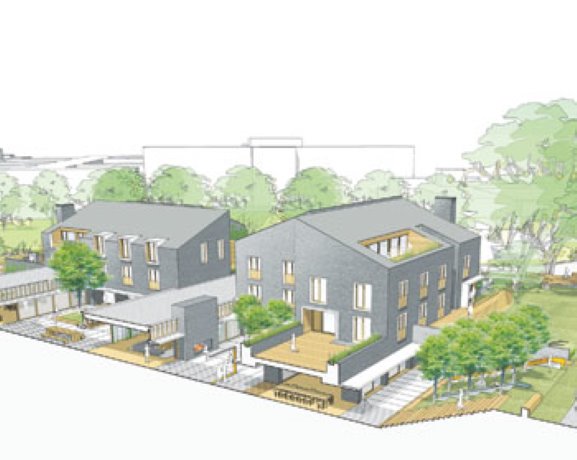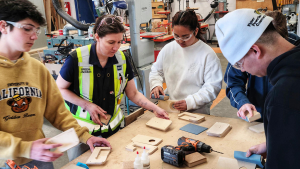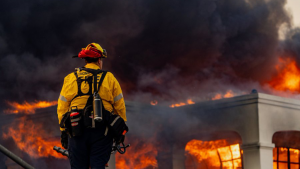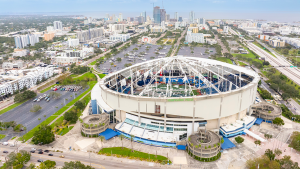A new generation of highrise commercial and institutional wood buildings are planned for B.C. in the next couple of years.
A new generation of highrise commercial and institutional wood buildings are planned for B.C. in the next couple of years.
The buildings will feature engineered wood products, such as cross laminated timber (CLT), laminated veneer lumber and laminated strand lumber.
The projects will ramp up the use of wood from the usual 2×4 wood frame construction, which is common in single family and multi-family residential projects.
The B.C. Building Code was recently changed to allow for the six-storey wood frame structures, up from the previous four-storey limit.
B.C.’s minister of jobs, tourism, and innovation, Pat Bell, recently announced plans for a new Wood Innovation and Design Centre in Prince George.
The wood commercial building will be six-storeys or taller. Construction is slated to start this year with a completion date of 2014.
Vancouver architect Michael Green, who has advocated for highrise wood structures up to 30-storeys, said he will soon tender the construction of the new Ronald McDonald House his firm has designed.
It will offer the second largest respite and family stay program in Canada and will be built near B.C. Children’s Hospital in Vancouver.
The four-storey structure will be built using a tilt-up mass timber system that utilizes CLT panels, Green said, adding that some will be built on site. The structure has a brick exterior envelope.
Green and engineer Eric Karsh co-authored a 240 page report A Case for Tall Wood Buildings commissioned by the Canada Wood Council for the Wood Enterprise Coalition. It introduces a new construction method using mass timber panels called FFTT (Finding the Forest Through the Trees).
“This is a whole new building system,” said Green, who believes Europe and Canada will lead the development of highrise wood structures, as building codes allow alternative solutions that show performance.
“If we have to wait for codes to change, we will wait another 10 years,” he said.
BC Wood CEO Brian Hawrysh said that while not everyone would be able to view the Prince George facility, the lowrise Ronald McDonald House will be more visible.
“The Ronald McDonald House will have more impact than a 10-storey building in Prince George,” he said.
However, his organization was supportive and is eager to see the new Prince George centre completed.
Wood highrises are not new to B.C. and other parts of Canada.
More than 100 years ago, architects were designing and construction firms were building wood structures up to 10 storeys tall.
Today, a 30-metre Vancouver heritage commercial building, the Landing, rivals a new generation London wood tower, the Stadthaus, that is touted as the world’s tallest wood building.
“Most buildings over the turn of the century were made that way,” said Erol Karacabeyli, an engineer and manager of building systems for FPInnovations.
He was speaking about the Landing’s heavy timber construction, commonly called post and beam.
After the First World War, the building method was replaced by steel and concrete, with lumber relegated to residential and lowrises.
Karacabeyli said B.C. evolved three basic wood building systems: the common 2×4 frame construction; the heavy timber or post and beam common in the older buildings; and the emergent mass timber style using CLT, laminated veneer lumber, or laminated strand lumber products in various dimensions and thicknesses.
Karacabeyli, who had some input into Green’s report, called it an excellent resource for information, peer reviews and contacts.
He also said it lays out a case for building systems according to their height.
From one to six storeys, he said, all three wood building systems would work.
For structures seven to nine storeys, alternate building solutions, using materials such as post-and-beam or mass timber should be an easily proven solution.
For highrise buildings of 10-12 storeys, more advance analysis of alternative solutions would be required.
For those rising above 13 storeys, more extensive analysis of alternative solutions for any mass timber and post-and-beam methods would be required.
“We are not saying that it is impossible,” he said, but added that a greater comfort zone with testing would be required.
However, information on mass timber construction is steadily growing.
FPInnovations has published a handbook on CLT for Canada, which is now being revised for the U.S. market.
As well, Hawrysh said BC Wood has lunch and learn sessions, originally for architects but now attended by contractors, where wood-products producers explain their wares.
B.C. has two CLT manufacturing plants, one in Penticton and one in New Westminster.











Recent Comments
comments for this post are closed